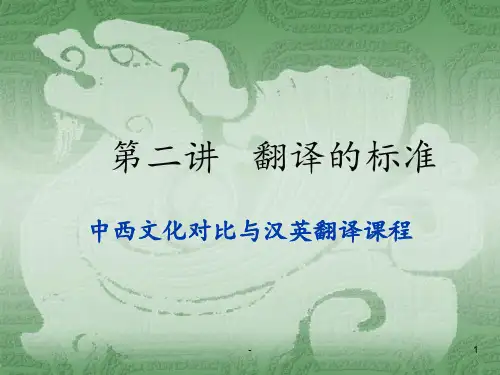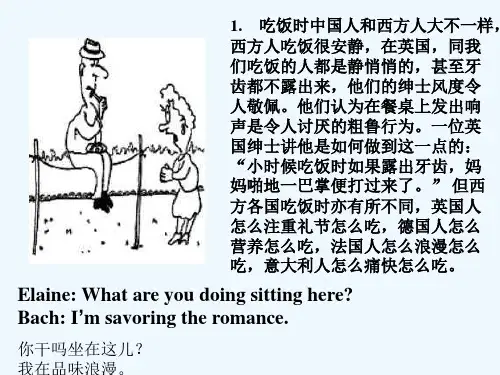中西文化之鉴 chapter1 课件
- 格式:pptx
- 大小:65.22 KB
- 文档页数:9










1. From what you know of the cultural grammar of the United States or another English speaking country, give advice to a Chinese English speaker about how to make a speech to a Western or International audience. (p24)The speaker should invent a new and attractive metaphor to carry their meaning. An image from their home culture might be fresher to her audience than their borrowed phrase.In Chinese culture a writer or speaker shows her learning by quoting famous people from the past. It is not necessary to even say where the quote comes from. The audience will know and will respect your knowledge. In the US people rarely quote famous people from the past unless it is an especially sentimental or patriotic occasion where it is understand that old and familiar images should be remembered. many people attend such events with an attitude of amused nostalgia(乡愁、怀旧之情).It might be fun to hear those old chiches again.(P23)2. Discuss the ways that hos ts in high-context cultures can meet the needs of low-context culture visitors for low-context information. (p61)Westerners appreciate the personal help they receive when they come to China, but they also want low-context information to help them plan, act and adjust to a new situation. High-context communicators need the low-context messages they receive, but without human helpers they experience their new cultural situation as cold and impersonal. Westerners want low-context information to help them plan, act and adjust to a new situation. They are more likely to assume that certain predictable services will be available such as hotel booking counters and transportation services and that they can find these and use them without any assistance.3. Discuss the ways that hos ts in low-context cultures can meet the needs of high-context culture visitors for high-context information. (p61)Westerners, as low-context communicators, look for, trust and use impersonal sources of information while communicators form more high-context cultures prefer personal sources of information. High-context communicators need the low-context messages they receive, but without human helpers they experience their new cultural situation as cold and impersonal. The hosts need to help them ready to various matters, so that they can quickly adapt to the new situation.4. Imagine that you are advising someone from China who is going on a extended trip to a low-context country. Explain to the person what changes he will need to make in his communication behavior in order to successfully communicate in a low-context culture. Then advise someone from a low-context culture on how he should change his communication beha vior inorder to communicate successfullyin China. (P65)Low-context communicatorsthink that the speakers and writersof words are responsible for thesuccess of communication. Theyshould make meanings clear andunderstandable with their words.Listeners and readers aresupposed to ask for clarification orfurther information if the words donot fully or clearly explain themeaning. In more informalsituations speakers willspecifically encourage listeners tointerrupt to ask questions.Low-context listeners andspeakers have similarexpectations in informalconversation. The speakerattempts to be clear and thelistener shows that he understandswith brief comments and facialexpressions. The speakersinterpret this as positive behavior.If the listener is silent it means thathe or she understands and acceptsthe message.High-context communicatorsexpect listeners to take moreresponsibility for interpreting themeaning of messages. Theyassume that speakers do notalways express their meaning fullyor precisely in words. It is up tothe listener to interpret themeaning of words by payingattention to the context in whichthey are said. From the point ofview of a low-contextcommunicator this sometimescauses high-contextcommunicators to find too littlemeaning in words and too muchmeaning in the situation.Differences in the significanceand reliability of messages sentthrough language and throughcontext are factors in almost allcross-cultural misunderstandingsbetween people from high-contextcultures and low-context cultures.The way people communicate ispart of their basic culturalsoftware, and it takes considerableeffort to modify this culturalprogramming to adjust tocommunicating situations that areculturally different. The first stepsare to understand thesedifferences and then to look forthem in every cross-culturalcommunication situation. By doingthis, high-context communicatorscan learn to use and respond towords differently and low-contextcommunicators can learn to payattention to context and learn tointerpret meaning in terms of thecontext.5. What is culture? How wouldyou explain the relationshipbetween language and culture?Culture is the total way of lifethat a group of people shares;Culture is a system of sharedbeliefs, values, customs, behaviors,and artifacts that the members of asociety use to cope with theirworld and with one another, andthat are transmitted fromgeneration to generation throughlearning.The close relationship betweenlanguage and culture is mostreadily seen in words. Words thatare intuitively recognizable arebasic units of nguage isa part of culture and plays a veryimportant role in it. Withoutlanguage, culture would not bepossible. On the other hand,language is influenced and shapedby culture, it reflects culture.Language is the carrier andcontainer of culture; it is themirror of culture. Language andculture is closely related, eachinfluencing and shaping each other.A language can never be learned ina culture vacuum.6. How do you understandindividualism in English culture?People from individualistcultures are more likely to act onprinciples that apply to everyone,principles that are universal andapply to associates and strangersalike. Individualists are more likelyto treat people they do not know asif they can be trusted, as if they,too, will behave according to thesame universal principles.Individualists are generallyconcerned about the processes ofdecision-making. Any behaviorthat attempts to seek an advantagefor one person over another basedon a personal relationship is seenas unfair or even as corrupt. Oftenindividualists strongly disapproveof attempts to gain preference, andthe person who does this may beseen as dishonest or unprincipled.7. How do you understandcollectivism in Chinese culture?Collectivism in Chineseculture means person belonging tothe society, personal interestsshould obey group, nationality,class and the interests of the state,it is a kind of spirit. The higheststandard of Collectivism is ourspeech and actions are accord withpeople's collective interests; thisis the communist world outlookand the important content of theproletariat. The scientific meaningis that while individual interestsand collective interests in conflict,we should subordinate to theinterests of the collective.8. What do you think of theadvantages ofindividualism-oriented values andcollectivism-oriented valuesrespectively?Individualism-oriented valuespay attention to individual value,freedom, and people withindividualism-oriented values maybe more innovative. Each person isseparate from others; he mayspeak his own mind and tell thetruth.Collectivism-oriented valueshave many advantages, such as thecooperate spirit .when makedecisions, the collectivists tend togive a higher priority torelationship than individualists do,they expect people who areinvolved in a group relationship tohave duties and obligations to oneanother. Duties include being loyaland furthering the interests ofgroup. So Collectivism-orientedvalues can let us makecontributions to group.9. What cross-cultural contrastscan you find between English andChines e responses tocompliments?In the west, people can e asy to accept compliments, because people are confident and frank. Chinese people are influenced by Confucian education for a long time, and formed the modest attitude. When people praise and praise, be modest or self-denial, otherwise, he or she may be treated as pride. The Chinese people pay attention to modest in communication, with the "humble yourself and people", to look at it as a virtue, it is one kind of rich Chinese culture characteristics of polite phenomenon. In others praise us, we tend to self-dispraise a to table modesty and polite. Western countries have no such cultural habits, when they are praise, there will always be very happy to say that a "yes" means to accept. Due to the differences between Chinese and western culture, we think the west too confident, not modest; When westerners heard Chinese people such a negative for their praise or hear their own negative their achievements, even those themselves naught, will feel very surprised.10. What cross-cultural differences can you find between English and Chinese modes of thinking?Western culture as linear cutting stroke, clear analysis, pay attention to abstract re asoning, analytical thinking, logical thinking.Chinese culture is like a circle sealed, viewing was close, seeking intuitive insight, good long image thinking.The Advantages of Each Mode of ThinkingThe linear mode of thinking characterized by analytical reasoning and emphasis on clarity and precision is conducive to theoretical construction. The circular mode of thinking characterized by synthetic insight and stress on fuzziness and implicitness contributes to empirical revelation of truth.11. What similarities and differences and you find between “ red “ and “红”?Red: in Chinese culture:Red is the color which Chinese people worship. The red color is usually associated with celebrations and joyful occasions. For Chinese, it’s the symbol of luck, happiness, success and festival. When festival comes, we h ang red lanterns, adhibit red couplet; wear red clothes (especially at the wedding ceremony). In china, “双喜” is either written in red or written on a piece of red paper to symbolize an event of special joy, such as a wedding or opening a business. Red: in Western culture: On the contrary, red has a rather bad meaning in western culture. It associates with blood, fire and evil. It’s the symbol of atrocity(残暴) , danger, violence, and debauchery(放荡). There are many phrases concerning red, for instance, “a red revolution”, “red alert”, “a red adventure story”, “a red flag”, “red battle”, “red ruin”, “a red light district”, all of which have derogatory senses.12. What similarities anddifferences and you find between“ white“ and “白”?White: in Chinese Culture: Whitehas derogatory sense in Chineseculture while it has acommendatory one in the west. InChina, it’s the symbol of death,depression, failure and threat.From of old, people have to wearwhite clothes as well as black oneswhen their relatives pass away.They regarded the white tigers asdemons. The losers waved whiteflags to show their surrender in thewars. White representsfoolishness when it’s used in theterm “白痴”. “白面书生” refers tothe bookman who is lack ofexperiences.White: In Western Culture: Inwesterners’ eyes, white equals tochastity and naivete. Bride wearswhite full dress at the weddingceremony. White Christmas: refersto snow at Ch ristmas time.Whitehope:refers to “a talented personwho is thought likely to bringsuccess or victory”.In conclusion, color terms implydifferent meanings in differentcountries. The preferencestowards different colors can showa nation’s aesthetic perception tosome extent. With thedevelopment of interculturalcommunication, I believe peoplewill know the cultural connotationof color words better.13.What similarities anddifferences and you find between“ blue“ and “蓝”?Blue:Blue has scarce symbolicmeaning in Chinese culture.Itdenotes gloomy emotion in thewest.(in a blue mood情绪低沉feelblue不高兴a blue outlook悲观的人生观)It is also regarded as thetoken of nobleness and sternness.Blue is also associated with highsocial position or beingaristocratic. It’s also the badge ofbawdry and indelicacy.Blue movie:a movie which contains obscenematerial h as explicit reference orportrayal of sexual acts.14.What similarities anddifferences and you find between“ black” and “黑”?Black: The concerned meanings ofblack in both eastern and westernculture are nearly the same. Itsymbolizes ferocity, seriousness,horror, death and blackness. InChinese, one use“黑心肠” todescribe someone who isvenomous. “黑幕” means frightfulsecret, inside story. In English,“black in the face” and “to lookblack at someone” are used to saypeople who are very angry. (西方文化中的“black” 既象征着死亡、罪恶和灾难,同时也象征着庄重,威严与尊贵。
